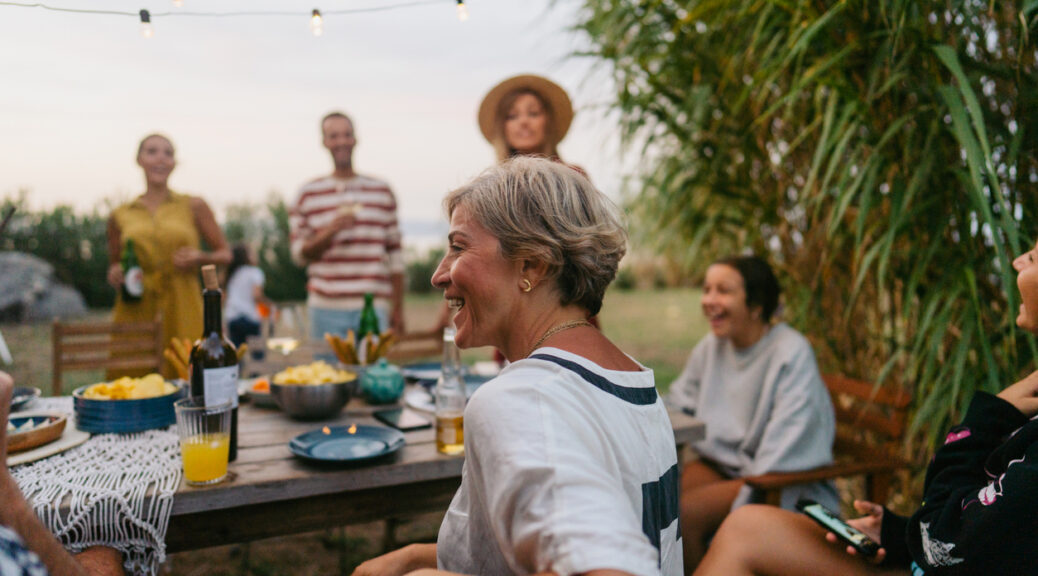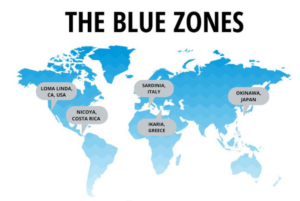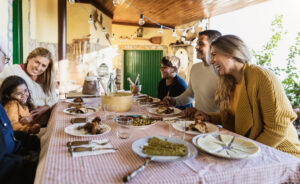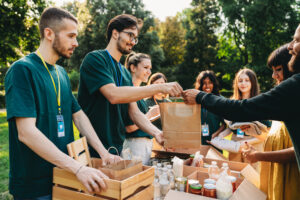What Blue Zones Teach Us About Strong Connections and Healthy Living

Think about the moments in life when you’ve felt truly connected with your family, your friends and your community. That’s what Blue Zones are all about too. The term “Blue Zones” refers to places where people live longer, happier lives because they’re surrounded by strong relationships and support.
Here at KVC Health Systems, connection is something we believe in deeply. It’s the heart behind our mission to enrich the lives of children and families. Whether it’s providing mental healthcare, social services or education, we’re here to help because we know that when people feel connected and supported, amazing things happen.
Let’s explore what’s so unique about Blue Zones, where strong social ties are integral to health and longevity, and how we can borrow behaviors from these regions to build healthier, happier, more connected futures for ourselves, our families and our communities.
What Are Blue Zones?
Blue Zones are geographic regions that harbor some of the world’s healthiest, longest-living inhabitants. The term was coined in 2004 by Dan Buettner, a National Geographic Fellow, award-winning journalist and bestselling author. During his explorations in Okinawa, Japan, Buettner found remarkable longevity of its residents. Inspired by this experience, Buettner set out to explore regions across the globe renowned for their high life expectancy.
With the backing of National Geographic, Buettner and his team of scientists and demographers traversed the world in search of communities where people not only lived longer but thrived in their later years. They went on to identify five regions, also known as Blue Zones. Each with its own story to tell: from the sunny shores of Icaria in Greece to the rugged hills of Sardinia, Italy.
 In these corners of the world, we encounter not just statistics but living, breathing testaments to the power of community, connection and resilience. The stories of Blue Zones remind us that the ability to positively shape our wellbeing rests in our hands. From Okinawa, Japan, where the wisdom of elders is revered and celebrated, to Loma Linda, California, where faith and family anchor life’s journey.
In these corners of the world, we encounter not just statistics but living, breathing testaments to the power of community, connection and resilience. The stories of Blue Zones remind us that the ability to positively shape our wellbeing rests in our hands. From Okinawa, Japan, where the wisdom of elders is revered and celebrated, to Loma Linda, California, where faith and family anchor life’s journey.
While genetics do play a part, what really stands out in Blue Zones are the lifestyle choices: eating nourishing foods and staying active with regular exercise. But it’s not just about living longer — it’s about living better. These Blue Zones offer a treasure trove of wisdom on how to forge deeper connections, prioritize family and create vibrant communities where everyone can thrive.
The Original Blue Zones
- Sardinia, Italy: Home to the world’s greatest concentration of men over 100, the people living in this mountainous region are known for working on farms and regularly drinking red wine.
- Okinawa, Japan: Home to the world’s longest-lived women, the people in this region are known for practicing Tai Chi and eating a diet heavy in soy-based foods.
- Loma Linda, California: People in this Seventh-day Adventist community outlive the average American by a decade. This is a tight-knit, religious community that’s strictly vegetarian.
- Icaria, Greece: With the lowest rates of dementia and one of the world’s lowest rates of middle-age mortality, those in this region follow a Mediterranean diet, rich in homegrown veggies, olive oil and red wine.
- Nicoya Peninsula, Costa Rica: With the world’s lowest rates of middle-age mortality, and the home to the second highest concentration of men over 100, people in this region have a sense of purpose called “plan de vida,” perform physical jobs into old age and follow a diet rich in beans and corn tortillas.
Why are Blue Zones Places of Longevity and Health?
 According to the CDC, the average life expectancy in the U.S. is 76 years. Yet, studies have revealed remarkable rates of nonagenarians (people who live over 90) and centenarians (people who live over 100) inhabiting Blue Zones. Only about 20-30% of an individual’s lifespan is dictated by genetic factors, which begs the question: what are people living in Blue Zones doing that the average American isn’t?
According to the CDC, the average life expectancy in the U.S. is 76 years. Yet, studies have revealed remarkable rates of nonagenarians (people who live over 90) and centenarians (people who live over 100) inhabiting Blue Zones. Only about 20-30% of an individual’s lifespan is dictated by genetic factors, which begs the question: what are people living in Blue Zones doing that the average American isn’t?
By studying these Blue Zones, researchers were able to identify nine common threads behind the remarkable health and longevity of these thriving communities. Known as the Power 9, these factors provide a roadmap to a healthier, happier life.
- Movement is naturally woven into each day
- Have a sense of purpose
- Prioritize stress relief
- Eat mindfully
- Eat a primarily plant-rich diet
- Consume alcohol in moderation
- Religious or spiritual belonging
- Put loved ones first
- Choose social circles that support healthy behaviors
The principles of health and longevity found in these zones have since spread, inspiring communities across the U.S. From California to Oregon, Minnesota and even Fort Worth, Texas, these ideas are taking root. They’re now helping people live more purpose-driven lifestyles with strong community ties.
Incorporating Blue Zone Principles Into Your Own Life
 While we can’t all just pack up and move to a Blue Zone, we can incorporate Blue Zone learnings into our lives to help cultivate meaningful, healthy futures. From making smarter food choices to adopting healthy habits to minimize stress, getting inspired by the Blue Zone lifestyle can seriously boost both our mental health and physical wellbeing.
While we can’t all just pack up and move to a Blue Zone, we can incorporate Blue Zone learnings into our lives to help cultivate meaningful, healthy futures. From making smarter food choices to adopting healthy habits to minimize stress, getting inspired by the Blue Zone lifestyle can seriously boost both our mental health and physical wellbeing.
The most important thing to remember? It’s okay to start small! Pick one or two of the Power 9 principles you want to focus on. Set small, realistic goals for yourself. For example, you don’t need a fancy gym membership if you need to get up and move your body more. Simply commit to going outside for a walk for 10 minutes each day and work your way up from there.
Here are some more healthy habits to help kickstart your wellness journey and forge new connections in your life:
- Partner up with an activity buddy. This could be a friend, classmate, coworker or family member with whom you share a common interest. Go bike riding, play chess in the park twice a week or take an art class together.
- Pencil in time for self-care and stress relief.
- Prioritize eating plant-based foods one day (or more!) a week.
- Practice positive self-talk and mindfulness.
- Disconnect from technology when sharing a meal with friends or spending time with family.
- Start volunteering in your local community with an organization meaningful to you.
- Join a local group to build connections around a common interest, like a book club or faith-based organization.
The Power of Connection in Health and Wellness
 Loneliness has a significant effect on our physical, mental and emotional wellbeing. Studies have found that loneliness can increase the odds of early death by 26 percent. We are hardwired for connection. In the Blue Zones, we see social connections helping people maintain thinking skills and slow cognitive decline as they age. Whether it’s a heartfelt conversation with a friend, a supportive hug from a loved one or a shared laugh with neighbors, these connections fuel our health and sense of belonging and purpose.
Loneliness has a significant effect on our physical, mental and emotional wellbeing. Studies have found that loneliness can increase the odds of early death by 26 percent. We are hardwired for connection. In the Blue Zones, we see social connections helping people maintain thinking skills and slow cognitive decline as they age. Whether it’s a heartfelt conversation with a friend, a supportive hug from a loved one or a shared laugh with neighbors, these connections fuel our health and sense of belonging and purpose.
Feeling properly connected with those around us might look different for each of us. But generally, it’s good to have a variety of social connections so we have many opportunities to both get and give support. Consider your social connections in three categories:
- Those you live with or are in contact with the most frequently (your partner, children, pets, etc.)
- Friends and family
- Your broader community
Feelings of disconnection in any of these categories might cause loneliness and impact wellbeing. Get some tips on how you can combat isolation and strengthen your social connections.
Finding Hope Through KVC
Just like in Blue Zones, where people live longer, healthier lives by prioritizing relationships, we believe in the power of meaningful connections to nourish the soul and enrich our lives. By embracing the fundamental human need for connection, we’re not just improving health outcomes, we’re creating communities where everyone feels seen, heard and valued.
At KVC, we know we all need connection. And we’re here to help. If you or someone you care about is struggling, remember that seeking help is a sign of strength, not weakness. We offer a range of resources and support services tailored to meet your needs, from family strengthening programs to mental health treatment. Learn more about the services we offer and discover how prioritizing wellbeing is a powerful step towards a healthy, fulfilling and connected life.





